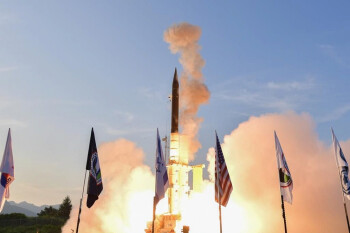Recently, Iran unleashed missile and drone attacks on Israel in revenge for Israel's suspected attack on its Damascus consulate. The attack began on April 14 at 20:00 and lasted until about 01:00 on April 15.
Since 2011, Israel's Iron Dome defense system has intercepted thousands of rockets and protected the country during times of conflict. It consists mainly of a three-part system that intercepts short-range rockets.
Arrow System
The arrow system, consisting of arrow two and arrow three, was designed to intercept ballistic missiles outside the Earth's atmosphere with a detachable warhead colliding with the target. It is Israel's most sophisticated anti-ballistic missile system in the world and has the longest range. Arrow three intercepts ballistic missiles and destroys them without using explosives while arrow two targets missiles in the upper atmosphere using explosives.

This system was developed by both Israel and the United States. Israel Aerospace Industries is the system's main contractor while Boeing produces the interceptors. The system works effectively since it operates at a high enough altitude to safely disperse non-conventional warheads.
David's Sling
David's sling is the middle layer of the Iron Dome's network. Like the arrow system, it was also co-produced with the United States. While it is similar to arrow two in that it does not use explosives, it only targets short to medium-range missiles, drones, rockets, and other threats. It has been operational since April 2017, bolstering Israel's second tier of its defense system.
Iron Dome
The Iron Dome heavily targets short-range projectiles such as missiles, drones, and artillery and serves as the system's bottom layer of Israel's air defense network. It uses radar to detect incoming threats and subsequently launch interceptor missiles carrying proximity warheads to protect the country. Additionally, it has a sophisticated communication system to relay guidance data.

It was developed by Israel's Rafael Advanced Defense Systems with the United State's partial funding and collaboration and became operational in 2011. The system is so effective that Ukraine has expressed interest in implementing a similar system as it continues its war with Russia. However, Israel has only provided civil defenses and humanitarian support so far.
Overall, Israel's Iron Dome system was effective in defending the country from Iran's unprecedented attack this past weekend. Thanks to billions of dollars of funding from Israel and its allies, the system features a complex array of technology.
Flights Cancelled in Philippines After Volcanic Eruption » LEVO: Revolutionizing Private Charter Travel with Joe Moeggenberg » Scoot's 12th Birthday: The Story of the Singaporean Low-Cost Airline »
Comments (2)
 Anton
You forgot to mention that the USAF knocked out most Iranian missiles and drones as well in a more limited way by planes from RAF, RJAF, UAEAF and even RSAF aircraft
Anton
You forgot to mention that the USAF knocked out most Iranian missiles and drones as well in a more limited way by planes from RAF, RJAF, UAEAF and even RSAF aircraft

Add Your Comment
SHARE
TAGS
INFORMATIONAL Israel Israel-Iran Iran Missile Defense Defense Boeing Middle EastRECENTLY PUBLISHED
 Flights Cancelled in Philippines After Volcanic Eruption
A violent volcanic eruption in the Philippines has forced airlines to cancel around 30 domestic flights. Large volcanic eruptions like the one that occurred in the Philippines post a significant threat to aviation safety.
NEWS
READ MORE »
Flights Cancelled in Philippines After Volcanic Eruption
A violent volcanic eruption in the Philippines has forced airlines to cancel around 30 domestic flights. Large volcanic eruptions like the one that occurred in the Philippines post a significant threat to aviation safety.
NEWS
READ MORE »
 Scoot's 12th Birthday: The Story of the Singaporean Low-Cost Airline
Celebrating its 12th birthday this past Tuesday, Singapore based low-cost carrier Scoot has left a significant impact on the global aviation industry. Founded in 2011 as a Singapore Airlines subsidy, Scoot has grown to become one of the largest and most successful long-haul low-cost airlines of the 21st century. Here's a look at the history of the 12-year-old Singaporean airline.
STORIES
READ MORE »
Scoot's 12th Birthday: The Story of the Singaporean Low-Cost Airline
Celebrating its 12th birthday this past Tuesday, Singapore based low-cost carrier Scoot has left a significant impact on the global aviation industry. Founded in 2011 as a Singapore Airlines subsidy, Scoot has grown to become one of the largest and most successful long-haul low-cost airlines of the 21st century. Here's a look at the history of the 12-year-old Singaporean airline.
STORIES
READ MORE »
 Rockwell Collins’ Integration of Proline Fusion Takes Avionics to New Heights
Discover how Rockwell Collins' Pro Line Fusion is revolutionizing aviation with Android-inspired technology, high-resolution synthetic vision, advanced data link capabilities, and touch flight displays.
INFORMATIONAL
READ MORE »
Rockwell Collins’ Integration of Proline Fusion Takes Avionics to New Heights
Discover how Rockwell Collins' Pro Line Fusion is revolutionizing aviation with Android-inspired technology, high-resolution synthetic vision, advanced data link capabilities, and touch flight displays.
INFORMATIONAL
READ MORE »




